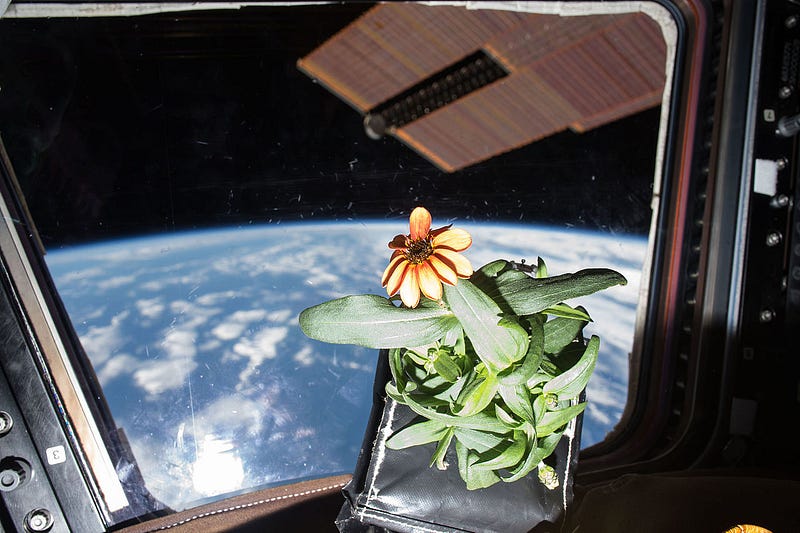Cosmic Cuisine
By Anushka Biswas, Cell and Molecular Biology, 2023

Day 152. Shifting through rations, you’re faced with the nightly dilemma: freeze-dried tofu with mustard or nutritional wildberry slurry? Every fibre of your mind and body longs for a carrot.
Welcome to life in space.
For astronauts aboard the International Space Station (ISS) or eagerly awaiting a six-month mission to Mars, many sacrifices must be made. Yet, the quality of food can be spared, if not improved, with space agriculture.
The ability to grow fresh vegetables in space provides copious merit for spaceflight. While it is completely possible to transport pre-packaged meals on space expeditions, packing food is both expensive and energy-intensive. Astronaut ice cream is by no means a long-term solution. Over time, the nutritional composition of food degrades and, for extensive journeys lasting upwards of five years, rations are shipped far in advance. Given the reduced gravity in spacecrafts, fluids within the astronauts’ bodies travel upwards and begin to accumulate — a phenomenon called fluid shift. The effects of fluid shift feel a bit like the common cold, causing heads to swell and a reduced sense of smell. Our intergalactic voyagers, in turn, lose their sense of taste and, eventually, weight from skipped meals. Even with a healthy diet, space flight comes with the qualms of spending months on end in isolation. The comforts of caring for another living organism suggest that growing plants can have a multitude of psychological benefits for astronauts. Being able to mark the passage of time on a seemingly endless, static expedition undoubtedly offers solace.
While it is completely possible to transport pre-packaged meals on space expeditions, packing food is both expensive and energy-intensive. Astronaut ice cream is by no means a long-term solution.
While there is significant incentive to cultivate crops amongst the cosmos, researchers struggle to bypass the environmental constraints of astronomic farming. Major concerns for astrobotanists include the thinner atmosphere of Mars and reduced plant yield in microgravity. Lunar and Martian soils are coarse and low in nutrients. The sharp angles of the soil particles themselves may pose a threat to the roots of the crops. Soil on Mars is extremely varied and high in metallic composition, full of iron oxide and perchlorates, capable of potentially stunting the growth of otherwise successful plants.
From the 1997 Mir Space Station to the current project Veggie, NASA has been fine-tuning the process of aeroponics to support plant growth in space. Aeroponics encompasses the process of growing plants suspended in air without soil or media. When well-implemented, aeroponics enables plants to grow faster and more sterile, without pesticide residue or contamination. The ISS Vegetable Production System is compact for accessible therapeutic gardening.
From the 1997 Mir Space Station to the current project Veggie, NASA has been fine-tuning the process of aeroponics to support plant growth in space.
Guowei Liu, of the Institute of Plant and Microbial Biology at the University of Zurich, recently published a study on the use of strigolactone, a plant hormone, in the presence of microgravity and nutrient deficiency. Plants were genetically edited to exude high levels of strigolactone to promote increased branching of their roots. Meanwhile, extraterrestrial conditions were simulated using a growth medium of synthetic lunar soil with mycorrhizal fungi. Mycorrhiza, a unique symbiotic relationship between plant and fungus, can greatly improve the viability of crops in nutrient-poor space by allowing plants to enlarge their root system. Microgravity was then mimicked via the use of a clinostat, a continuously rotating equipment that holds and positions the plants randomly. Results were promising, as the genetically edited plants displayed extended branching even under microgravity and were generally taller with greater biomass production. Inducing excess strigolactone may allow for more reliable growth of sustainable plants in space.
Currently, astrobotanists are pursuing the growth of salad crops, which grow quickly and efficiently while being easily influenced by light therapy.
Currently, astrobotanists are pursuing the growth of salad crops, which grow quickly and efficiently while being easily influenced by light therapy. Being able to consume vegetables without extensive cooking or cleaning is a significant advantage in a limited environment. Specific crops of interest include herbs, radishes, and lettuce strains — more specifically red lettuce. Weiger Wamelink of Wageningen testifies that, compared to other crops, red romaine lettuce has selective properties that aid in repairing DNA damage from solar radiation, to which astronauts are prone, as well as a low microbial count. The long-term goal, however, is to prioritize stable crops like potatoes. Potatoes, high in energy and essential nutrients, tell us The Martian might have had the right idea after all.
It is said that once you grow crops somewhere, you colonize it. With recent developments making astrobotany an up-and-coming discipline, we are one branch closer to extending our roots and settling in on Mars.
DOI: 10.1038/s41526–018–0054-z
DOI: 10.1104/pp.47.6.756